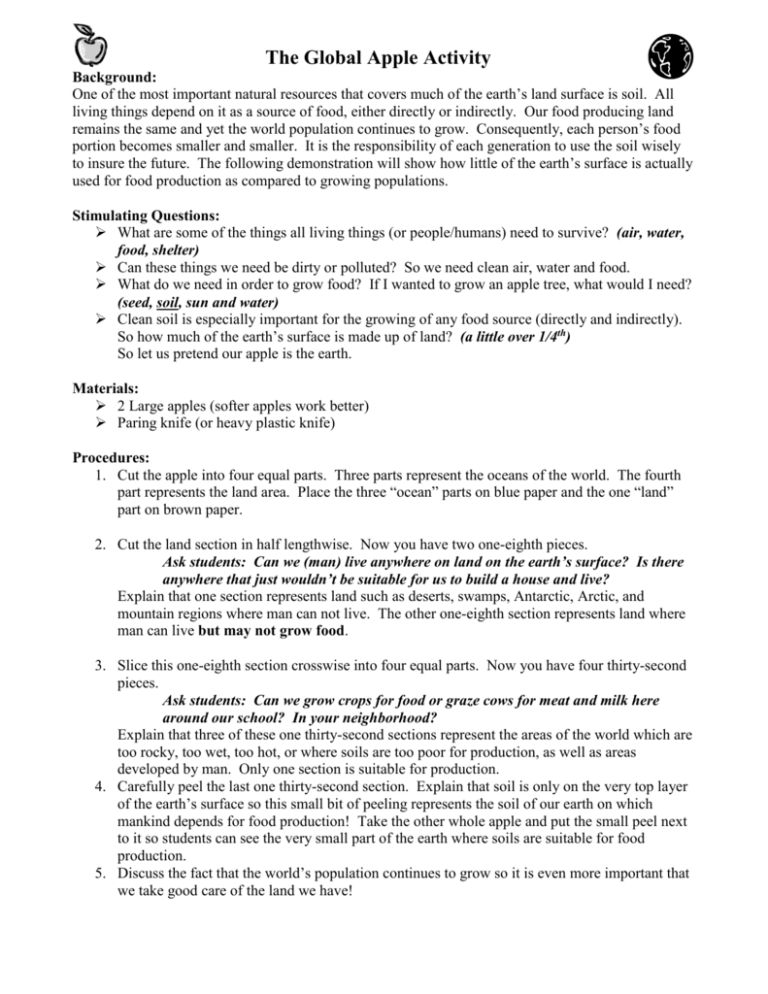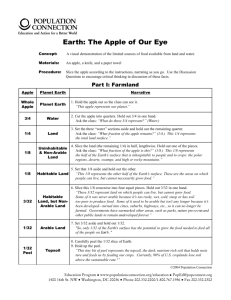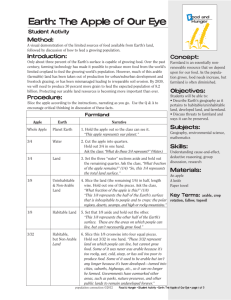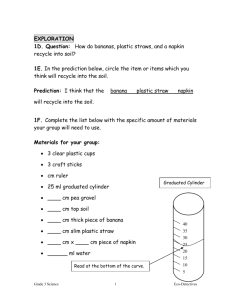The Global Apple Activity
advertisement

The Global Apple Activity Background: One of the most important natural resources that covers much of the earth’s land surface is soil. All living things depend on it as a source of food, either directly or indirectly. Our food producing land remains the same and yet the world population continues to grow. Consequently, each person’s food portion becomes smaller and smaller. It is the responsibility of each generation to use the soil wisely to insure the future. The following demonstration will show how little of the earth’s surface is actually used for food production as compared to growing populations. Stimulating Questions: What are some of the things all living things (or people/humans) need to survive? (air, water, food, shelter) Can these things we need be dirty or polluted? So we need clean air, water and food. What do we need in order to grow food? If I wanted to grow an apple tree, what would I need? (seed, soil, sun and water) Clean soil is especially important for the growing of any food source (directly and indirectly). So how much of the earth’s surface is made up of land? (a little over 1/4th) So let us pretend our apple is the earth. Materials: 2 Large apples (softer apples work better) Paring knife (or heavy plastic knife) Procedures: 1. Cut the apple into four equal parts. Three parts represent the oceans of the world. The fourth part represents the land area. Place the three “ocean” parts on blue paper and the one “land” part on brown paper. 2. Cut the land section in half lengthwise. Now you have two one-eighth pieces. Ask students: Can we (man) live anywhere on land on the earth’s surface? Is there anywhere that just wouldn’t be suitable for us to build a house and live? Explain that one section represents land such as deserts, swamps, Antarctic, Arctic, and mountain regions where man can not live. The other one-eighth section represents land where man can live but may not grow food. 3. Slice this one-eighth section crosswise into four equal parts. Now you have four thirty-second pieces. Ask students: Can we grow crops for food or graze cows for meat and milk here around our school? In your neighborhood? Explain that three of these one thirty-second sections represent the areas of the world which are too rocky, too wet, too hot, or where soils are too poor for production, as well as areas developed by man. Only one section is suitable for production. 4. Carefully peel the last one thirty-second section. Explain that soil is only on the very top layer of the earth’s surface so this small bit of peeling represents the soil of our earth on which mankind depends for food production! Take the other whole apple and put the small peel next to it so students can see the very small part of the earth where soils are suitable for food production. 5. Discuss the fact that the world’s population continues to grow so it is even more important that we take good care of the land we have!











